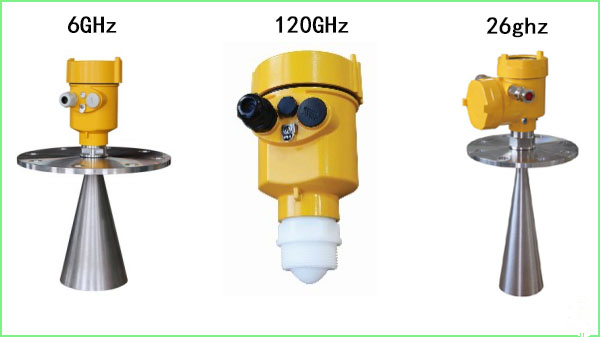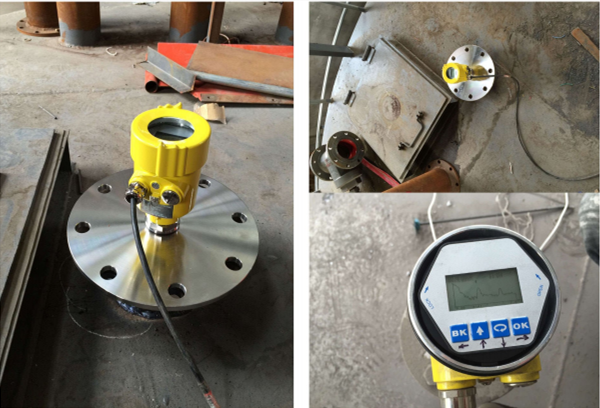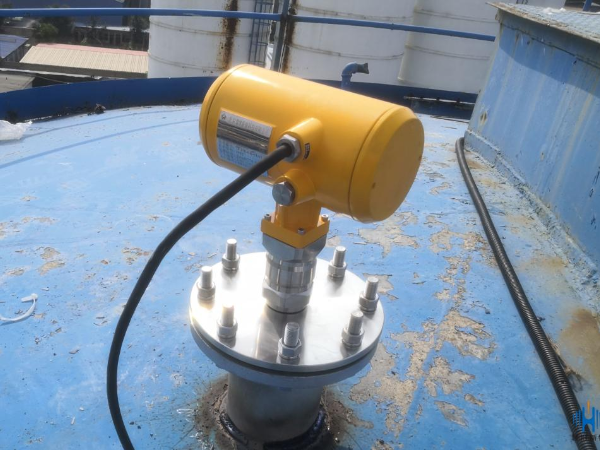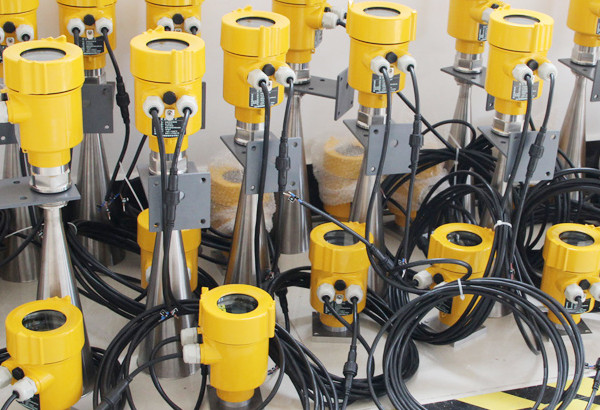Radar level meter in the blast furnace tank level detection, in general, can not be affected by the process temperature, pressure, steam, or dust, and can achieve non-contact, maintenance-free measurement. However, in actual production, there are problems that cannot be measured normally due to the accumulation of dust at the lower end of the radar level meter receiver. Then, through the renovation, the high-pressure nitrogen gas pipe from the gas package, solenoid valve, and control device is installed at the receiver of the level meter to form an automatic blowback system, which can effectively prevent the occurrence of the above problems and provide technical guarantee for the accurate measurement of the level of the material tank and the smooth production.

Radar level meter measurement principle
Usually, the radar level meter uses the physical properties of electromagnetic waves to carry out the level measurement, through the probe antenna located at the top of the pre-storage room to transmit continuous frequency modulation of high-frequency radar electromagnetic waves, continuous detection of the measured material surface. When the radar wave signal is reflected by the material surface, the return wave is received by the antenna, and the instrument analyzes the frequency difference between the reflected wave and the transmitted wave to calculate the interval time, so as to know the space height and reflect the level height.

Radar level meter emission wave anti-blocking technology is insufficient
Metallurgical blast furnace tank radar level meter emission wave anti-blocking technology, such as the design of the probe on the level meter connected to the gas source blowback device, or maintenance workers use every maintenance time to dismantle the equipment for manual cleaning of the level meter receiver, etc., can solve the technical problems of preventing the level meter probe and receiver mouth ash accumulation.
However, there are still the following shortcomings: After the blast furnace tank level meter has been in operation for a period of time, the level detection is out of order due to dust, water vapor, and other media condensing in the tank and being deposited at the receiver opening, which cannot be removed by itself.
At this time, the blast furnace operator can not continuously monitor the material level changes in the tank, and in the event of abnormal storage or inlet and outlet of material in the tank is not found and handled in time, resulting in accidents.
Radar level meter emission wave anti-blocking technology can not solve the technical problem of automatic removal of ash accumulation at the receiver of the blast furnace tank radar level meter during production, so that the material level can be detected continuously and normally, thus providing a safety guarantee for the production.

How to carry out technical transformation
In view of the deficiencies of the original metallurgical blast furnace tank level meter emission wave anti-blocking technology, through the implementation of technical transformation, the lower part of the radar level meter receiver at an appropriate location welded from the nitrogen package of high-pressure nitrogen blowback tube, the nitrogen gas pipe installed solenoid valve, and control devices to form an automatic blowback system, can effectively prevent the level meter receiver mouth due to the accumulation of ash and can not be measured normally.
A vertical hole is made in the lower side of the radar level meter receiver, and the size is suitable to match the size of the cutout of the blowback tube with the slanting cutout. Match the slant cut end of the blowback tube with the vertical hole opened at the lower end of the radar level meter receiver, and meet the angle between the centerline of the blowback tube and the centerline of the level meter receiver ≤ 10°; weld the slant cut end of the blowback tube with the vertical hole opened in the receiver along the hole. Select a suitable location on the blowback tube, the normally closed solenoid valve installed in the selected location ( Note: the direction of the solenoid valve should not be installed in reverse, the selection parameters to match the working medium pressure, differential pressure, power supply, etc.). On the other end of the blowback tube and a high-pressure container nitrogen package butt welding, the nitrogen package role is high-pressure (0. 4 MPa ≤ N2 pressure ≤ 0. 6 MPa) energy storage.

It should be noted that in the design of the high-pressure vessel, in the case of a certain volume, using a larger height to diameter ratio to meet the requirements.
In the front and rear of the solenoid valve, take a suitable position on the blowback pipe, and install the front ball valve and the back ball valve, in the maintenance or manually open and close the high-pressure nitrogen, the two ball valves are normally open. The radar level meter detection signal is connected to the PLC system, and the level value is displayed on the computer monitoring screen.
In the program for blowback control settings, when the blast furnace tank discharge gate opens count N times, take this time the discharge gate closed, the tank again before feeding the tank residual pressure dissipation, the PLC control output starts, the solenoid valve is powered to act once.
At this time, the solenoid valve opens, and the nitrogen gas in the high-pressure accumulator nitrogen package is instantly sprayed to the level gauge receiver in the tank, and the dust deposited at the receiver is instantly flushed clean.
Through the implementation of technical transformation, the design and installation of the automatic back-blowing device on the level gauge receiver of the metallurgical blast furnace can effectively solve the automatic removal of the accumulated ash at the receiver of the radar level gauge during production, so that the level is continuously and normally detected.
